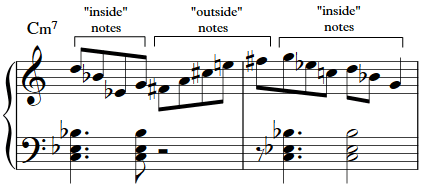In this article we’ll look at three tips for the practice of advanced funk improvisation. Although these three concepts are often used in the funk idiom they can be used in all genres of music. Advanced funk improvisation can include a voluminous amount of music theory and practice topics, but here we’ll discuss side-stepping, quartal structures, and pentatonic scales.
Advanced Funk Improvisation: Side-Stepping
Side-stepping is a term jazz players sometimes use to refer to the idea of “outside” playing. Side-stepping basically means that a player identifies the notes which are contained within a particular key or chord scale (what we call the “inside” notes). But then, the player intentionally avoids those inside notes and instead plays the “outside” notes. Shortly after playing these outside notes, the player resolves back to the inside notes again. This kind of playing is what advanced players call “taking it out.”
So, why might a musician want to intentionally play these “outside” notes, what some might refer to as “wrong” notes? Because when done properly, it sounds awesome. It’s yet another example of tension and release in music. The “out” notes build tension because they inherently clash with the chord over which they’re being played. But when these “out” notes eventually resolve back “inside” the listener hears dissonance and then resolution. The effect can be very powerful when done properly.
Listen to McCoy Tyner on “Passion Dance,” Cory Henry on “Lingus,” and Michael Brecker on the “The Chicken” for some excellent examples of side-stepping and see if you can identify instances of its use.
Advanced Funk Improvisation: Quartal Structures
The term “quartal” refers to music that is built in 4ths, either perfect 4ths or augmented 4ths. Quartal voicings refer to chords that are stacked in 4ths. Below is a C dorian scale and the quartal voicings that can be created from the notes of that scale.
These are great chord ideas for comping over a C minor 7 harmony. But they also provide the basis for great solo ideas. Playing solo lines using quartal structures (i.e., improvisation based in intervals of 4ths) can sound very cool, advanced, and funky.
Advanced Funk Improvisation: Pentatonic Scales
Pentatonic scales are where some advanced jazz and funk players really shine. Pentatonic scales are 5-note scales (“penta” = five, “tonic” = tones). Just as there are 12 major and relative minor scales, there are 12 major and relative minor pentatonic scales.
To build a major pentatonic scale you use the 1st, 2nd, 3rd, 5th, and 6th scale degrees of a major scale.
To build a minor pentatonic scale you use the 1st, 3rd, 4th, 5th, and 7th scale degrees of a natural minor scale.
As you can see from the image above, the major and relative minor pentatonic scale use the exact same notes.
Pentatonic scales can be used in a variety of ways, but perhaps learning a few patterns is one of the best places to start in funk. Check out the following pattern over a C minor 7 chord and see if you can transpose it to some other chords.




